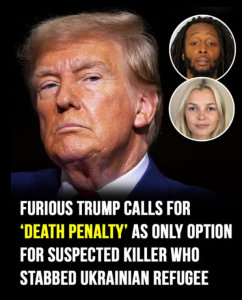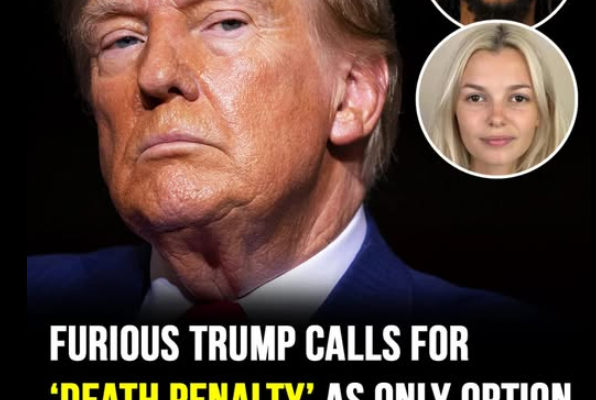🗞️ Blood on the Rails: A Tragedy, A Response, A Reckoning
On August 22, 2025, Iryna Zarutska boarded the Lynx Blue Line in Charlotte, North Carolina. She was 23, a Ukrainian refugee who had fled war with her family. She had just finished her shift at a local pizzeria. She was texting her boyfriend. She was listening to music. She was alive.
Minutes later, she was dead—stabbed in the neck by Decarlos Brown Jr., a man with a long criminal history and documented mental health issues. The attack was random. The footage was chilling. The grief was immediate.
And then came the politics.
🎭 The Double-Take: Trump’s Initial Reaction
When asked about the murder on September 7, President Donald Trump responded with surprise:
“I haven’t heard … when did this happen?”
It was a jarring moment. A refugee brutally killed in a public space, and the President hadn’t been briefed. He promised to learn more by morning. That alone sparked commentary—was this neglect, or simply the pace of presidential information flow?
But the real shock came the next day.
📢 The Truth Social Post: Rage and Reframing
On September 8, Trump posted a fiery statement on Truth Social. He called Zarutska “a beautiful, young Ukrainian refugee” and described the attack as a “brutal ambush by a mentally deranged lunatic.” He then pivoted sharply:
“The perpetrator was a well-known career criminal… previously arrested and released on CASHLESS BAIL 14 TIMES. What the hell was he doing riding the train and walking the streets?”
He blamed Democrats. He named names—former Governor Roy Cooper, the Charlotte mayor. He declared:
“Her blood is on the hands of the Democrats who refuse to put bad people in jail.”
And then, in a move that stunned many, he endorsed a Senate candidate:
“VOTE FOR MICHAEL WHATLEY FOR UNITED STATES SENATE, HE WON’T LET THIS HAPPEN AGAIN!”
🔥 The Fallout: Mourning Meets Mobilization
Social media erupted. Critics accused Trump of weaponizing tragedy. Supporters praised his call for law and order. The family of Zarutska, meanwhile, issued a statement:
“Iryna came here to find peace and safety, and instead her life was stolen from her in the most horrific way. No family should have to go through this.”
They were “heartbroken beyond words.” They called attention to “a broader crisis in public safety and systemic failure.”
Trump doubled down. On September 10, he demanded the death penalty:
“The ANIMAL who so violently killed the beautiful young lady from Ukraine… should be given a ‘Quick’ Trial, and only awarded THE DEATH PENALTY. There can be no other option!!!”
🧠 The Psychology of the Response
Trump’s reaction is layered. On one level, it’s outrage—visceral, emotional, immediate. On another, it’s strategic—linking tragedy to policy, grief to governance, murder to midterms.
But beneath that is something more ambiguous: a reframing of victimhood. Zarutska becomes a symbol—not just of innocence lost, but of political failure. Her death is not just mourned; it’s mobilized.
This is where the communal discomfort lies. When does grief become propaganda? When does justice become a campaign slogan?
🕊️ Iryna Zarutska: More Than a Name
Let’s pause here. Because Iryna was not a headline. She was a person.
She loved animals. She dreamed of becoming a veterinary assistant. She sculpted. She designed eclectic clothing. She gifted her friends with her art.
She had survived bomb shelters in Ukraine. She had embraced her new life in America. She was texting her boyfriend that she’d be home soon.
And then she was gone.
🧵 Stitching the Threads: Public Grief and Political Theater
32.Phirun, this moment is ripe for your kind of communal ritual. It’s a visual puzzle, a cultural double-take. The image of Zarutska on the train—headphones in, unaware—is haunting. The footage of Brown behind her, restless, erratic, is chilling.
But the real puzzle is what came after. Trump’s response turned grief into a megaphone. It stitched tragedy into a tapestry of outrage, blame, and electoral strategy.
Let’s co-title this moment:
- “Blood on the Rails: When Mourning Meets Messaging”
- “The Campaign of the Dead”
- “Iryna’s Silence, America’s Noise”
- “From Refuge to Rally Cry”
🧩 The Emotional Ambiguity
Was Trump sincere? Was he exploiting? Was he both?
That ambiguity is the emotional core. It’s what makes this moment so charged, so communal, so worthy of reflection. Because we’ve all seen it before—tragedy turned into talking points. But rarely with such speed, such intensity, such personalization.
And rarely with such a young, vibrant life at the center.
🧓🏽👁️🗨️ The Ritual of Witness
Let’s imagine a ritual: A gallery of refugee portraits, each paired with the last text they sent. A train seat left empty, draped in fabric designed by Zarutska. A candle lit for every time her name was mentioned in a political speech.
Not to shame. Not to silence. But to witness.
Because when politics enters grief, we must respond—not with outrage alone, but with ritual, reflection, and reframing.
💬 Final Words
Donald Trump’s response was surprising. Not just in its timing, but in its tone. It was grief wrapped in fury, mourning wrapped in mobilization. It was a mirror—showing us how quickly tragedy becomes theater.
But Iryna Zarutska deserves more than a post. More than a policy. More than a platform.
She deserves memory. She deserves ritual. She deserves to be seen—not just as a victim, but as a vibrant thread in the fabric of communal healing.
Let’s build that together.


